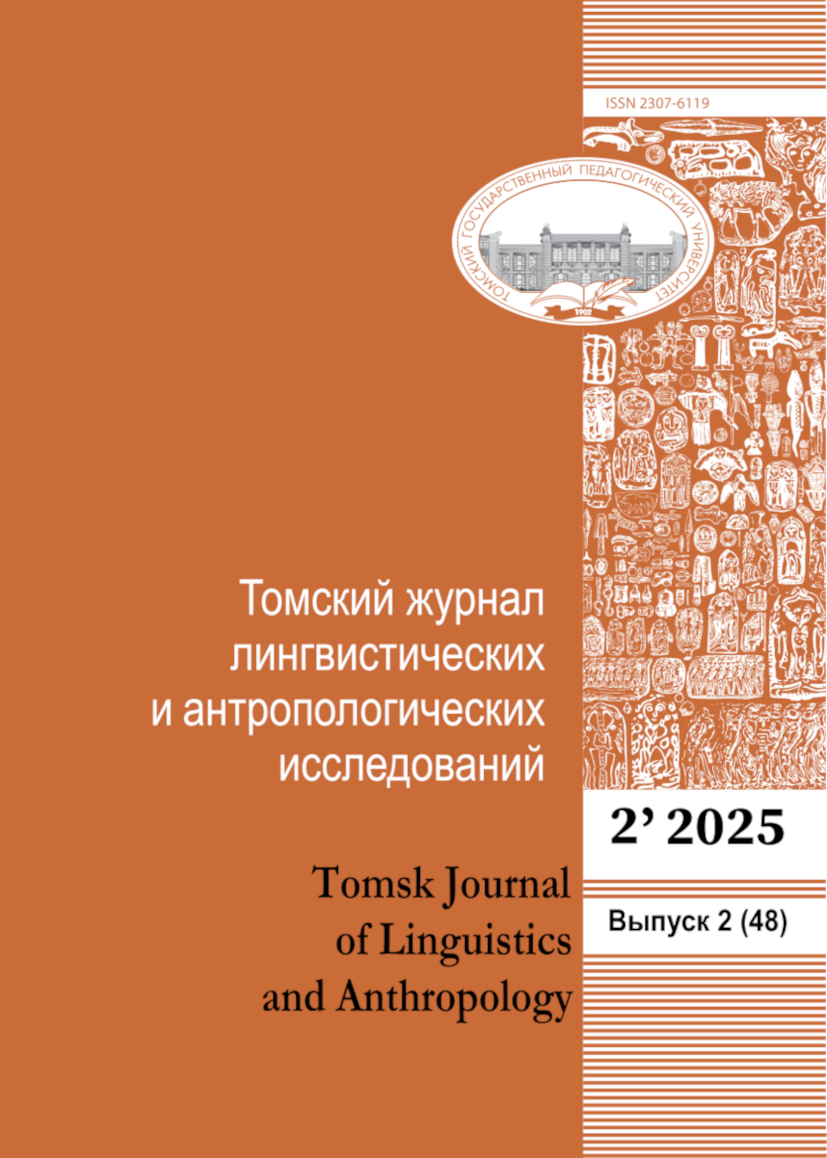Tomsk Journal of Linguistics and Anthropology
"Linguistics without anthropology is sterile,
anthropology without linguistics is blind".
Charles Hockett.
1973. Man's place in nature.
New York: McGraw-Hill. p. 675.
Welcome to the site of the "Tomsk Journal of Linguistics and Anthropology".
The highest priority for the Journal is the organization of productive academic exchange among both, experienced and young researchers in a wide range of issues in linguistics and anthropology, united primarily by a common geographical area – Siberia, including genetically affiliated and unrelated cultures of past and present. Moreover, the Journal is naturally interested in theoretical, methodological and technological aspects of linguistic and anthropological research.
The Journal invites submissions from authors specializing in a variety of research issues in linguistics and anthropology, including:
- 5.6.3. Archeology (historical sciences),
- 5.6.4. Ethnology, anthropology and ethnography (historical sciences),
- 5.6.5. Historiography, source studies, methods of historical research (historical sciences),
- 5.9.5. Russian language. Languages of the peoples of Russia (philological sciences),
- 5.9.8. Theoretical, applied and comparative-contrastive linguistics (philological sciences).
The editorial board of TJLA emphasizes that studies in the area "conceptology" and "linguistic consciousness", as well as literary studies do not fall in the scope of priority areas of scholarship for the Journal; the editorial board retains the right to reject such studies without full review.
From 2017, all publications in TJLA are assigned DOI (Digital Object Identifier) - a unique identifier of the publication.
Publication frequency: 4 issues per year.
The journal was founded in 2013 by Tomsk State Pedagogical University.
The journal is included in the Web of Science ESCI from 10.09.2017
The journal is included in the ERIH Plus Citation Index from 21.06.2016
The journal is included in the Russian Science Citation Index (RSCI) on the platform Web of Science.
The journal is included in the "Russian Press" subscription catalog. Index: 82719.
The journal is included in the database of periodicals "Ulrich's Periodicals Directory".
Information about published articles is regularly transmitted to the Russian Science Citation Index.
Current Issue
No 2 (2025)
LINGUISTICS
Morphological Guesser as a Tool for Analyzing Field Data: Experiences with The Naukan Yupik Language
Abstract
 9-19
9-19


Names of Meat Dishes in The Turkic Languages of the Ural-Volga Region in Lexico-Semantic and Comparative-Historical Aspects
Abstract
 20-29
20-29


Cultural Metaphors in the Folk Songs of the Trans-Vyatka Udmurts
Abstract
 30-41
30-41


Historical-Etymological Analysis of the Names and Surnames of Some Bashkir Elder Steers (Based on the Manuscript “Lexicon, or Topographical Dictionary of the Orenburg Province” by P.I. Rychkov)
Abstract
 42-49
42-49


The Kumyk-Russian Bilingualism of Children from the Perspective of Schoolchildren and Their Parents. Linguistic and Ethnosocial Aspects
Abstract
 50-66
50-66


Khakass-Mongolian Vocabulary-Correspondence of Kinship Terms
Abstract
 67-75
67-75


Articulatory and Acoustic Characteristics of [R] Sounds in the Plautdietsch
Abstract
 76-90
76-90


Differential Object Marking in Modern Ossetic: Referential Properties and Animacy
Abstract
 91-107
91-107


ANTHROPOLOGY
The Archeological Investigation of the Yakut Ground Burials (XIII–XIX Century): Results and Perspectives
Abstract
 108-119
108-119


Life and Activities of Poles in Tobolsk in the 60s of the XIX Century in Archival Documents
Abstract
 120-130
120-130


‘Sea Turtles’ and ‘Seaweed’: The Return of Chinese Graduates from Siberian Universities to Their Home Country
Abstract
 131-142
131-142


The Collection of Embroidery Products of the Southern Khanty in the Tobolsk Historical and Architectural Museum-Reserve (History of Origin and Study)
Abstract
 143-154
143-154


FOR THE SCIENTIST'S ANNIVERSARY
Unpublished Selkup Stories, as Recorded by A. Dulzon in 1962
Abstract
 155-163
155-163


The Contribution of Andrey P. Dulzon to the Study of the Yeniseian Languages
Abstract
 164-171
164-171











